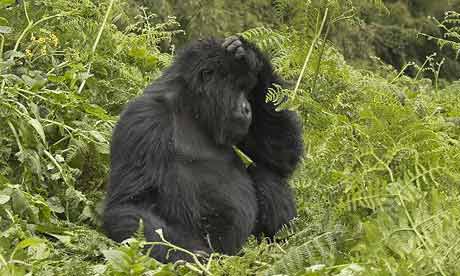· Calculations of risk found to be seriously flawed
· Most-endangered may be months from extinction

Mountain gorilla in the Virunga Mountains of Rwanda. Photograph: Andy Rouse/Corbis
Endangered species could become extinct 100 times faster than previously thought, scientists warned yesterday in a bleak reassessment of the threats to global biodiversity. They say methods used to predict when species will die out are seriously flawed and dramatically underestimate the speed at which some will disappear.
The findings, presented in the journal Nature, suggest that animals such as the western gorilla, the Sumatran tiger and Malayan sun bear, the smallest of the bear family, may become extinct much sooner than conservationists had feared.
Ecologists Brett Melbourne, at the University of Colorado at Boulder, and Alan Hastings at the University of California, Davis said conservation organisations should use updated extinction models to urgently re-evaluate the risks to wildlife. "Some species could have months instead of years left, while other species that haven't even been identified as under threat yet should be listed as endangered," said Melbourne.
The warning has particular implications for the International Union for Conservation of Nature (IUCN), which compiles an annual "red list" of endangered species. Last year the list upgraded western gorillas to critically endangered, after populations of a subspecies were found to have been badly affected by Ebola virus and the commercial trade in bushmeat.
The Yangtze river dolphin was listed as critically endangered, but could possibly be already extinct.
The researchers analysed mathematical models used to predict extinction risks and found that while they included some factors crucial to predicting a species' survival they overlooked others. For example, models took into account the fact that some animals died from rare accidents such as falling out of a tree. They also included chance environmental threats, such as sudden heatwaves or rainstorms that could kill off animals.
But what the extinction models failed to include was the proportion of males compared with females in a population, and the differences in reproductive success between individuals in the group. When they factored these aspects into risk assessments for particular species they found the danger of extinction rose substantially.
"The older models could be severely overestimating the time to extinction. Some species could go extinct 100 times sooner than we expect," Melbourne said.
The researchers showed that the missing factors - the number of males to females, and variations in the number of offspring - were capable of causing unexpected large swings in the size of a population, sometimes causing it to grow but also increasing the risk that a population crashed and became extinct.
To test the new models, Melbourne's team studied populations of beetles in the laboratory. "The results showed that the old models misdiagnosed the importance of different types of randomness, much like miscalculating the odds in an unfamiliar game of cards because you didn't know the rules," he said.
For some endangered species, such as mountain gorillas, conservationists could collect data on individuals and plug the information into models to predict these animals' chances of survival.
"For many other species, like marine fish, the best biologists can do is measure abundances and population fluctuations," Melbourne said.
Craig Hilton-Taylor, who manages the IUCN red list in Cambridge, said extinction estimates were often inadequate. "We are certainly underestimating the number of species that are in danger of becoming extinct because there are around 1.8m described species and we've only been able to assess 41,000 of those."
The latest study could help refine models used to decide which species are put on the red list, he said. "We are constantly looking at how we evaluate extinction risk, and it may be they have hit on something that can help us."
More than 16,000 species worldwide are threatened with extinction, according to a 2007 report from the IUCN. One in four mammal species, one in eight bird species and one in three amphibian species are on the organisation's red list. An updated list is due to be published in October.
Next week, the IUCN is expected to highlight the dire state of the world's corals after surveying the condition of more than 1,000 species around the world.

No comments:
Post a Comment